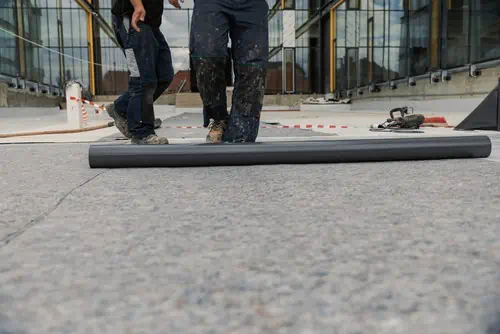When protecting a building from water damage, one key question often comes up: How many types of waterproofing membranes are there? The answer includes a range of materials and systems, each designed for different surfaces and conditions. Whether you’re working on a basement or a rooftop, choosing the right membrane can make all the difference. At Sourco Waterproofing Solutions, we provide reliable, high-performance waterproofing systems to meet every need.
What Are Waterproofing Membranes?
Waterproofing membranes are special barriers applied to surfaces to stop water from entering. They protect walls, roofs, and foundations from moisture, mold, and corrosion. At Sourco, we make it easy to find a waterproofing solution that fits your building.
There are two main categories of membranes: liquid-applied and sheet-based. Each has its own benefits and uses, depending on the structure and environment. Below, we explore these types and explain how they work.
1. Liquid-Applied Waterproofing Membranes
Liquid membranes are spread or sprayed directly onto surfaces. After drying, they form a seamless coating that blocks water. These membranes work especially well on uneven or tricky areas like balconies and around pipes.
Benefits:
- No seams, joints, or gaps
- Easy to apply even on detailed surfaces
- Adapts to surface movement
Common Types:
Polyurethane Membranes
Polyurethane coatings are flexible, durable, and stick well to many materials. They handle temperature changes and are ideal for areas with constant movement. At Sourco Waterproofing Solutions, we offer trusted polyurethane systems for both indoor and outdoor spaces.
Acrylic Membranes
Acrylics are eco-friendly, UV-stable, and simple to apply. They’re perfect for exposed rooftops or vertical walls.
Cementitious Coatings
Although not flexible, cement-based membranes are strong and reliable. Use them for water tanks, basements, or bathrooms. With our skilled team, even small spaces get a solid layer of protection.
2. Sheet-Based Waterproofing Membranes
Sheet membranes come in rolls and are stuck to surfaces using heat, glue, or fasteners. Because they’re made in factories, their thickness stays consistent, which helps improve quality.
Benefits:
- Strong resistance to punctures
- Quick installation
- Great for large, flat areas
Types of Sheet Membranes:
Bituminous Membranes
These are made with asphalt and modifiers like SBS or APP. They work well on flat roofs and foundations. Our bituminous options at Sourco offer long-term protection, even in rough weather.
EPDM Membranes
EPDM is a rubber membrane that performs well under sun, heat, and stress. It’s a top choice for flat roofs or ponds. Plus, our self-adhesive EPDM makes application faster and cleaner.
PVC and TPO Membranes
PVC offers chemical resistance and fire safety, while TPO provides strong seams and fights mold and dirt. Both are great for commercial roofs. Our team installs these thermoplastic membranes using heat welding for added strength.
Polypropylene Membranes
Light but strong, these are often used on concrete roofs or gutters. Our reinforced polypropylene sheets are perfect for large roofs and exposed areas.
3. Specialty Waterproofing Membranes
Some projects need something extra. That’s where special membranes come in.
Self-Adhesive Membranes
These are easy to apply, thanks to a sticky underside. They work well in basements or humid places. At Sourco Waterproofing Solutions, we offer reliable self-adhesive products that stick tight and last long.
Hot-Applied Bituminous Membranes
These membranes are applied while hot and create a thick, bonded layer. Use them for decks, podiums, or green roofs, especially in cold weather.
Coal Tar Pitch Membranes
Though not as common today, coal tar is still used where chemicals or tough conditions are present. Our experts can advise if this traditional choice fits your needs.
Thermoplastic Membranes
These flexible sheets, often made of TPO or PVC blends, are sealed using hot air. They offer excellent performance for large buildings or commercial spaces.
Choosing the Right Waterproofing Membrane
With many types available, choosing the right one depends on the surface, environment, and your budget. Here’s what to consider:
- Surface type – Concrete, wood, or metal?
- Water pressure – Is it below ground or exposed to heavy rain?
- Movement – Will the surface expand or contract?
- Exposure – Is it facing sunlight, chemicals, or foot traffic?
At XX Waterproofing Solutions, we make this process simple. Our experienced staff will assess your project and recommend the best system. Plus, we’ll handle delivery, guidance, and post-installation inspection to ensure long-term success.
Trusted by Professionals
Builders, engineers, and property owners trust Sourco to protect their investments. We work across industries—residential, commercial, and industrial—to deliver lasting waterproofing results.
Here’s why people choose us:
- High-quality materials
- Certified installers and specialists
- Personalized service and advice
- Fast turnaround and fair pricing
Real-World Applications
Waterproofing membranes are used in a wide range of areas:
- Foundations and basements – Keep underground spaces dry
- Flat roofs and green roofs – Protect large surfaces from leaks
- Bathrooms and kitchens – Prevent mold and water damage
- Balconies and decks – Handle heavy rain and temperature changes
- Water tanks and pools – Maintain water tightness over time
Every structure deserves protection from water damage. That’s why we help you find the right membrane for the job—and make sure it works from day one.
Conclusion
So, how many types of waterproofing membranes are there? The answer is more than just a number. It’s about choosing the right system for your specific need. Whether you prefer a liquid coating or sheet-based solution, Sourco Waterproofing Solutions is here to help. We offer full support—from selection to installation—to ensure your structure stays dry, safe, and sound.


